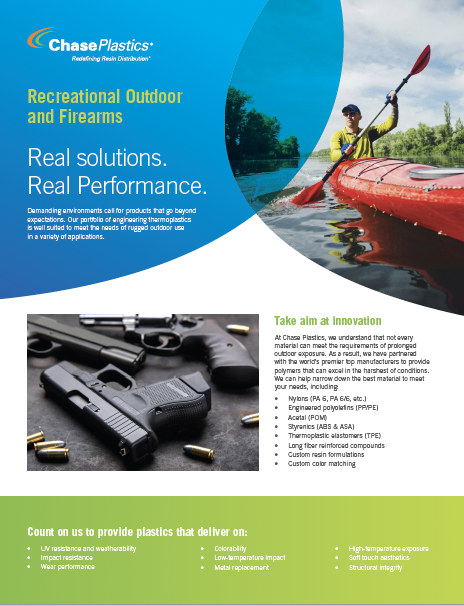For centuries, firearms have been predominately made of metal construction. Only in recent years, around the 1980s, did manufacturers start looking to use plastic in their firearm applications. Although a newer development in the firearm market, plastics have many advantages over steel, making it an excellent choice for certain components. The following are reasons to consider plastic in a firearm application:
• Lightweighting: handguns with steel frame construction can see up to a 40% reduction in weight moving to a nylon frame.
• Greater design and aesthetic freedom: in-mold textures for components like grips, pre-color, and masterbatch colorant options to achieve market-specific MIL-Spec colors, like flat dark earth (FDE), olive drab, and desert tan.
• Corrosion resistance: an inherent property of plastics
• Reduced recoil: improving ease of use of the firearm
• Serviceability: easier and more cost-effective to replace plastic components of firearms vs. metal
• Cost reduction: overall production cost of plastics is lower with fewer costly secondary operations vs. metal
Today, components like the slide and barrel remain constructed out of metal because of factors like temperature resistance that make plastics not a great option. Though most other components of the firearm can be designed and made of plastics, components like grips, frames, stocks, receivers, etc. In recent years, the military has even approved the use of plastic magazines. Some of the standard plastic materials used in firearms would include, but are not limited to:
• Short chain nylons (ex: PA 6, PA 6/6): used for their excellent chemical and heat resistance, as well as their great wear and friction performance
• Long-chain nylons (ex: PA 6/12): can be great for use in humid environments where their lower moisture absorption provides an improvement in dimensional stability
• Aromatic nylons (ex: PARA, PPA, HPPA): also provides great dimensional stability, as well as higher temperature resistance and improved surface appearance (especially in glass or carbon-filled options)
• High-temperature crystalline materials (ex: PPS, PEEK): excellent heat performance, retention of mechanical properties at elevated temperatures, and excellent chemical resistance.
• Thermoplastic elastomers (ex: TPE-s, TPV, TPU): broad range of hardness options available to help with ergonomics and vibration dampening.
• Long fiber-reinforced compounds (ex: long glass, long carbon): available in all the above material options, long fiber materials have the mechanical improvement seen with short fiber compounds without as much loss in impact.

Recreational outdoor and firearms solutions
Whether new to the firearms market or looking for new technologies for existing components already being produced, the Engineering Team here at Chase Plastics is ready and willing to walk you through any analysis needed to offer firearm application material recommendations.
Give us a call at 844-411-2427 or send an email to engineering@chaseplastics.com to get support on any of your technical questions today!
If you have questions on the topic above or another issue to tackle, please submit your inquiry in the questions/contact form to the right. Someone from our Technical Team will be in touch within 2 hours!
